Time Line: 1976 - 1980
1976 |
|
| Jan. '76 | Tour promoting Nighthawks At The Diner: October 1975 - August 1976 (album released: October, 1975). Tom Waits: vocals, acoustic guitar, piano. Frank Vicari: tenor saxophone. Dr. Fitz(gerald) Jenkins: upright bass. Chip White: drums. Further reading: Performances: 1976-1980 |
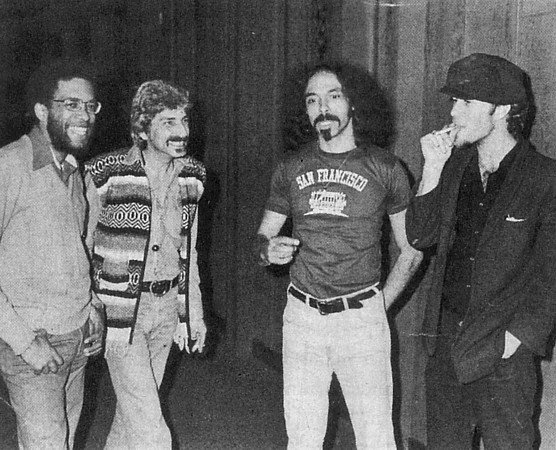 |
w. the Nocturnal Emissions (1976 tour band): Fitz Jenkins, Frank Vicari and Chip White as printed in “Lowside Of The Road: A Life Of Tom Waits" by Barney Hoskyns (Faber/ Broadway, 2009). Date: late 1976. Credits: courtesy of Chip White |
| Feb. 3, '76 | TV appearance for the "Dinah Shore TV Show" (Warm Beer And Cold Women). With Joey Bishop, James Coco and Bert Convy. Aired February 3, 1976 (recorded January 13, 1976).
Tom Waits (1976): "I must admit that I hoisted up six tall cool ones in the back with the stage crew, before I actually went out into the limelight, and I got to sing one song and sit on the panel...she had a good personality. It was a little awkward I must admit. I was at the end of the couch....but they talked to me, they tolerated me..." (Source: unidentified BBC Interview, 1976) |
| Feb. 11, '76 | Second interview by Constant Meijers for Dutch magazine "Muziekkrant OOR" (Nr. 3). TW: "I saw Bruce in Philadelphia... and he killed me, just killed me." The interview was probably done in September or October 1975 |
| May 31 - Jun. 12, '76 | Ronnie Scott's Club. London/ UK. Waits at the age of 26. He stays in London for about two weeks and writes most of the songs for his next album: "Small Change". "For three nights he sat at the piano, peering out at the empty seats through a haze of smoke from the cigarette cemented to his bottom lip, performing his songs of wry and melancholic beauty. On the fourth night they threw him out. 'I think it was my clothes', Waits says now.".
Fred Dellar (1976): "There is heckling. "Your opinions are like assholes, buddy," comes the voice from beneath the cap. "Everybody's got one." The fans at the back yell "Shut up!" to the front-line main-mouths. Waits flicks a lighted cigarette into the central area of contention and everybody holds their breath waiting for a fight to start. Nothing happens, so Waits moves on to deliver a finger-poppin' work-out on 'Diamonds on My Windshield' the tempo being about twice that employed on the Heart Of Saturday Night version." (Source: "Tom Waits: Ronnie Scott's London". By Fred Dellar. New Musical Express. June 12, 1976) Tom Waits (1987): "That was a tightrope. The rope was round my neck. Nightmares. Playing a lounge in the middle of a golf course with this nomadic audience all waiting for a Moroccan jazz combo. That was a rough gig. Two weeks! Man, I had to dry out after that one. That was like spending two weeks at somebody else's grandmother's house. It was miscasting I was miscast." (Source: "I Just Tell Stories For Money" New Musical Express magazine (UK), by Sean O'Hagan. Date: Travelers Cafe/ Los Angeles. November 14, 1987) |
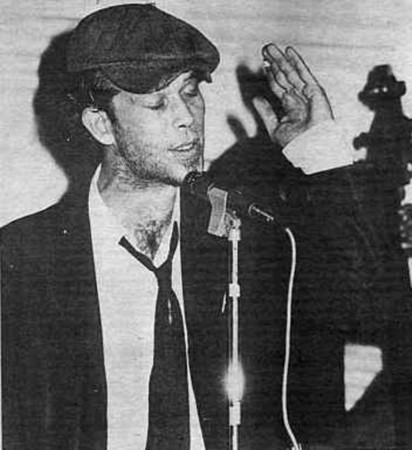 |
Ronnie Scott's Club London. Source: ZigZag magazine, 1976. Credits: photography by Chalkie Davies |
| Late May '76 | TV appearance for "The Old Grey Whistle Test". BBC/ UK. Presented by Bob Harris (The Piano Has Been Drinking). |
| Jun. 3, '76 | Interview for ZigZag Magazine: "Watch Out For 16 Year Old Girls Wearing Bell Bottoms...". London/UK, by Peter O'Brien. |
| Jun. 5, '76 | Interview for New Musical Express (UK): "Would You Say This Man Was Attempting To Convey An Impression Of Sordid Bohemianism". Fred Dellar |
| Jun. 10, '76 | Published: interview for HUMO magazine (Belgium). "Tom Waits: "Alle mensen waar ik van hou zijn gek of ziek of dood" by Marc Didden |
| Jun. 11, '76 | Published: "Play It Again Tom". Interview with New Times magazine (USA), by Robert Ward |
| Jun. 14, '76 | Interview for Newsweek magazine: "There's a common loneliness that sprawls from coast to coast. It's like a common disjointed identity crisis. It's dark, warm narcotic American night. I just hope I'm able to touch that feeling before I find myself one of these days parked on Easy street". Carter/ Greenberg in Los Angeles/ USA |
| Jun. 17, '76 | Interview for Down Beat magazine: "Bitin' The Green Shiboda With Tom Waits". Chicago/ USA, Marv Hohman |
| Jun. '76 | End tour promoting Nighthawks At The Diner: October 1975 - June 1976. Further reading: Performances: 1976-1980 |
| Summer '76 |
In June 1976 Waits was still living in the Silver Lake area. Shortly after he moved to a larger apartment at 1309 North Coronado Street in Echo Park (Source: Bobi Thomas interview as quoted in “Lowside Of The Road: A Life Of Tom Waits" by Barney Hoskyns. Faber/ Broadway, 2009). Apparently Waits only lived there for a couple of months, because in December 1976 Waits had already moved in the Tropicana. |
| Jul. 15 - 20, '76 | Recordings for the album "Small Change" at Wally Heider Recording, Hollywood/ USA |
| Sep. '76 | Released: "Small Change" (Asylum Records). Produced by: Bones Howe. Backed by the late Shelly Manne (percussion)
"Bones Howe knew that the songs Waits was now bringing to him were as good as anything he had ever written, so he stepped back and allowed Waits to develop his vision. "My purpose was to make the best record that I could with Tom. Tom is, and has been from the very beginning, very strong about what he wants on his records. He was not a produced artist, ever. As Albert Grossman used to say, I just delivered the baby, you know? [Tom] was the creative engine. But I did make a lot of suggestions, I think, that helped him. Tom always said that with each record I held the bar a little higher for him to jump over.' And Small Change was a success - critically and commercially. The album far outsold any of Waits's previous albums, particularly Nighthawks at the Diner. With it, Waits broke onto Billboard's Top 100 Albums chart for the first time in his career (he wouldn't manage it again until 1999, with the release of Mule Variations). Suddenly Tom Waits was everywhere. He was profiled in all the music publications. Interviewers from such magazines as Time, Newsweek, and even Vogue lined up to talk to him. Waits remarked that his mother had never been entirely sure that a career in music was right for her son until she saw him looking back at her from the pages of Vogue. This was as close as Waits had ever come to being a rock star, and, given the choice between being an obscure cult artist and a cult artist with a sizable following - well, that was a decision Waits didn't need to mull over. He sat back and enjoyed what was happening to him. Waits had toured solo for years, but now, thanks to the money and prestige that Small Change had brought him, he was able to put together a regular band. He called it The Nocturnal Emissions, and it featured Frank Vicari on tenor sax, Fitzgerald Jenkins on bass, and Chip White on percussion and vibes. They toured the United States extensively, and a number of those tour shows were broadcast on radio. Then they headed for Europe, where Waits had wowed the critics and consumed a few pints of ale the year before. They performed in Germany, Holland, and then Japan."(Source: "Wild Years, The Music and Myth of Tom Waits". Jay S. Jacobs, ECW Press 2000) |
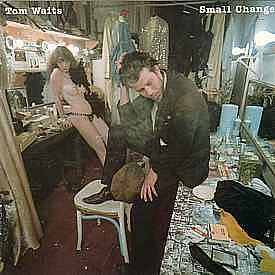 |
Cover for the album: "Small Change". Design by: Cal Schenkel. Photography by: Joel Brodsky |
| Late '76 | Released: single: "Step Right Up"/ "The Piano Has Been Drinking" (Asylum) |
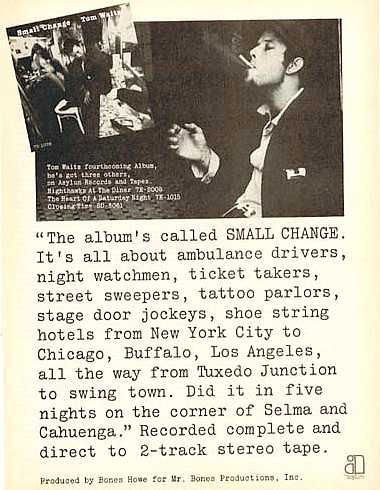 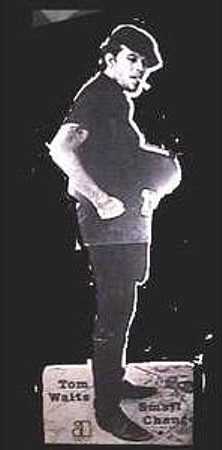 |
L) Asylum ad promoting "Small Change" R) Asylum life size promotional standup promoting "Small Change". Photography by Mitchell Rose (1976) |
| Oct. '76 | Start tour promoting Small Change: October 1976 - May 1977 (album released: September, 1976) Tom Waits: vocals, acoustic guitar, piano. Frank Vicari: tenor saxophone. Dr. Fitz(gerald) Jenkins: upright bass. Chip White: drums. Further reading: Performances: 1976-1980 |
| '76 | Released: "Songs For The New Depression" (Atlantic) by Bette Midler with a cover off "Shiver Me Timbers" |
| Nov. 19, '76 | TV appearance (interview) for the "Mike Douglas TV show", Philadelphia/ USA (Small Change). Directed by Don Roy King. Host: Mike Douglas. Guests: British actress Glenda Jackson, composer/conductor Marvin Hamlisch and Tom Waits |
| TV screen shot. Chain smoking and having "a good time" at the Mike Douglas show... | |
| Dec. '76 | Waits has moved from his apartment on North Coronado Street in Echo Park to the Tropicana on Santa Monica Boulevard in West Hollywood. |
| Dec. 07, '76 | "On Tom's twenty-seventh birthday, he and The Nocturnal Emissions played the Agora Ballroom in Cleveland. While Tom was doing "Pasties and a G-String" a woman slipped onstage, walked up behind him, caught his eye, and started to dance. Waits got into it, assuming that she was an audience member acting on impulse, but his shock was apparent when she started to perform a slow, sensual striptease. Shimmying out of her dress, the woman revealed her very own pasties and G-string. Waits regained his equilibrium and sang along to the stripper's bump and grind. As the song ended the woman disappeared back into the crowd and Waits joked, "Thank you, thank you. I haven't seen my mother in years."' Nocturnal Emissions drummer Chip White explained to a European radio interviewer how all of this actually came about. Tom didn't know it, but that seemingly impromptu striptease was, in fact, a birthday surprise arranged for him by John Forscha, his road manager and old friend from L.A. It was an inspired gift: Waits enjoyed the spectacle so much that he had Forscha hire a local stripper at every remaining tour stop. Band members got to the point where they'd rate the girls. At the end of the tour, they tallied the points and named the Madison, Wisconsin stripper the hottest of the hot." (Source: "Wild Years, The Music and Myth of Tom Waits". Jay S. Jacobs, ECW Press 2000) |
| Dec. 30, '76 | Interview for Rambler magazine: "The Ramblin' Street Life Is The Good Life For Tom Waits". Chicago/ USA, Rich Trenbeth |
| Late '76 | Interview by David McGee for Rolling Stone. Waits lives at the LA Tropicana, but at that moment he's temporarily at the NY Chelsea. |
1977 |
|
| Jan. '77 | "While the band was playing in Japan, [Chip] White recalls, Tom met a very nice woman. They got along well, but there must have been some sort of language-based misunderstanding, because the woman was somehow convinced that Waits had proposed marriage to her. Unaware of having entered into any such bargain, Tom returned to the States along with the band. They were scheduled to do a gig with Jimmy Witherspoon at the Roxy on Sunset Strip not long afterward, and, in the middle of their set, there was a car crash outside on the boulevard. The electricity went out and the Roxy was plunged into darkness. As club staff scrambled to get some candles lit, Tom's Japanese friend showed up. She'd flown all the way to Los Angeles to see her new fianc�. It soon became clear that the power wasn't about to be restored, and clubs up and down the strip emptied out onto the sidewalk. A huge block party ensued. Nightclubbers mingled with drinks in their hands, smoking and chatting. Among them stood Tom Waits, talking to his Japanese visitor, trying hard to explain that he just wasn't looking to get married." (Source: "Wild Years, The Music and Myth of Tom Waits". Jay S. Jacobs, ECW Press 2000) |
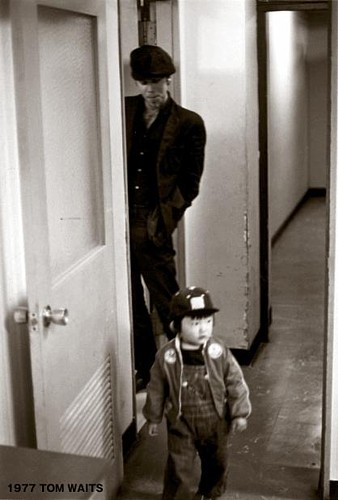 |
Tom Waits in Japan (Copyright/ source: Tom's Cabin Productions, 1977) |
| Apr. '77 | Published "Tom Waits - Offbeat Poet And Pianist". Interview for Contemporary Keyboard magazine, by Dan Forte |
| Apr. 9, '77 | TV appearance for the "Saturday Night Live, TV show", New York/ USA (Eggs And Sausage). |
| Early May '77 | TV appearance for "The Old Grey Whistle Test" BBC. London/ UK (Small Change & Tom Traubert's Blues) |
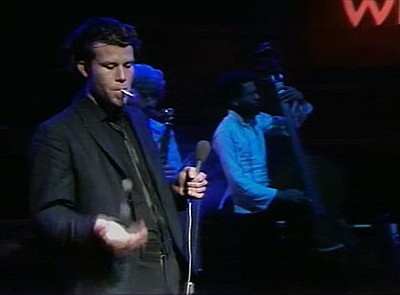 |
TV screenshot from "The Old Grey Whistle Test", 1977 |
| May '77 | End tour promoting Small Change: October 1976 - May 1977. Further reading: Performances: 1976-1980 |
| May 27, '77 | Tom Waits and Chuck Weiss, arrested for "disturbing the peace" at Duke's Tropicana Coffee Shop (Tom Waits arrested in L.A. Delores Ziebarth. Rolling Stone p.15. Jul. 14, 1977). Further reading: Waits And The Cops |
| '77 | Released: the album: "I'm Everyone I've Ever Loved" (ABC) by Martin Mull. With: "Martin Goes And Does Where It's At" (spoken word) |
| Aug. 1, '77 | TV appearance/ interview for "Fernwood2night" (sequel 21). Further reading: Fernwood2night |
| TV screenshot from: "Fernwood Tonight" (TAT Communication & Co.) | |
| Aug. '77 | Tom Waits and Chuck E Weiss were found not guilty in a unanimous decision by a 12 person jury on 2 charges of disturbing the peace. Waits and Weiss have filed a claim against the county for false arrest, false imprisonment, assault and battery, intentional infliction of emotional distress, malicious prosecution and defamation of character. They are asking for $100,000 each in general damages and reimbursement of attorney fees and court costs." (Source: "Random Notes". Rolling Stone p. 29-31. Aug. 11, 1977). Further reading: Waits And The Cops |
| Jul. 28 - Aug. 15, '77 | Recordings for the album "Foreign Affairs". Collaboration with Bette Midler and first collaboration with Greg Cohen. GC: "Waits auditioned us all at once, so he couldn't really tell how well each of us played, individually. He ended up hiring the whole band. At the time, I was playing with a lounge band in Los Angeles, doing the schlocky pop tunes of the day, so Tom rescued me from all that."(Source: "Side Man". George Kanzler. Newark Star Lodger p. 22. May 22, 1999) |
| Sep. '77 | Released: the album "Foreign Affairs" (Elektra Entertainment). Produced by: Bones Howe. In the credits it says: "Chuck E. Weiss is back in town". Round this time Waits is acquainted with: Chuck E. Weiss and Art Fein (who was working at the Elektra-Asylum publicity department)
Jay S. Jacobs (2000): "He talked to me about doing this other material," Bones Howe recalls. Waits was ready to record again, and he described to Howe his method for putting Foreign Affairs together. "He said, 'I'm going to do the demos first, and then I'm gonna let you listen to them. Then we should talk about what it should be. 'I listened to the material and said, 'It's like a black-and-white movie.' That's where the cover came from. The whole idea that it was going to be a black-and-white movie. It's the way it seemed to me when we were putting it together. Whether or not it came out that way, I don't have any idea, because there's such metamorphosis when you're working on [records]. They change and change."" (Source: Telephone conversation with Jay S. Jacobs. Jun. 23, 1999. Wild Years, The Music and Myth of Tom Waits. Jay S. Jacobs, ECW Press 2000) |
| Cover for the album: "Foreign Affairs". Photography by: George Hurrell | |
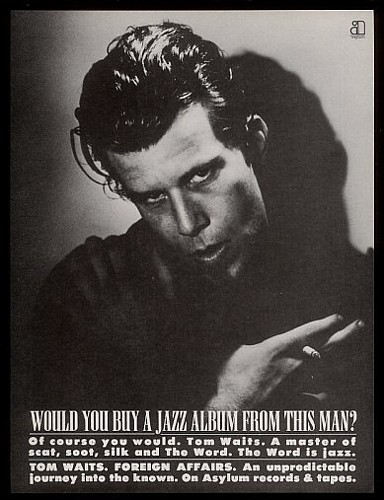 |
Magazine ad promoting "Foreign Affairs". Photography by: George Hurrell |
| Dec. 22, '77 | Published: "The Odyssey Of Tom Waits". Interview for Circus magazine (USA), by David Koepp. Issue nr. 171 |
| Late '77 | At about this time Waits and Rickie Lee Jones start an affair. They both live at the LA Tropicana. Further reading: Rickie and Chuck |
1978 |
|
| Feb. 5, '78 | Incident with L.A. punk band The Bags "Thrashing Of The Troubadour" |
| '78 | Rickie Lee Jones demo-recordings for A & M. Warners (Waronker/ Templeman) contracts her for her debut album |
| Mar. '78 | Interview for Creem Magazine: "Tom Waits: The Slime Who Came In From The Cold". San Francisco/ USA, Clark Peterson |
| May 25, '78 | TV appearance for "America2night" (sequel 34). With Martin Mull. Further reading: America2night |
| Mar. '78 | �nd tour promoting Foreign Affairs: October 1977 - March 1978. Further reading: Performances: 1976-1980 |
| Apr. '78 | Waits travels to London/ Paris to discuss plans for a book with Rock Dreams artist Guy Peellaert |
| Jul. 15, '78 | Interview for New Musical Express (UK): "The Bad Liver And Broken Heart Brigade". By Nick Kent |
| Jul. 24 - Aug. 26, '78 | Recordings for the album "Blue Valentine" at Filmways/ Heider Recording, Hollywood/ USA |
| Sep. 7, '78 | Released: movie and soundtrack album "Paradise Alley" (w. Sylvester Stallone). On soundtrack: "Meet Me In Paradise Alley" and "Annie's Back In Town". Movie debut as pianist "Mumbles"
"Bones Howe remembers that Sly and Tom "got to be friends somehow or other. Maybe Sly saw him at the Troubadour or met him through somebody. I have no idea. He was suddenly there. But it wasn't unusual, because Tom had a way of accumulating people. Chuck E. Weiss. Rickie Lee Jones. People just sort of appeared all of a sudden." Stallone offered Waits the small role of Mumbles and asked him to record some songs for the Paradise Alley sound track album. Tom jumped at the chance to act, and the part was perfect for testing his wings. Mumbles, a piano player at a neighborhood saloon, wasn't exactly a stretch for him. Howe recalls that in the end he and Tom only contributed a couple of songs to the film's sound track - "Bill Conti was really upset because he wanted to do all the source music himself. He and Sly were very close, but Sly wanted Waits in that movie." Conti, a jazz musician, had scored Rocky, and he was thrilled when the movie's rousing, horn-based theme rose to the top of the pop charts. Of the five tracks that Waits and Howe recorded for Paradise Alley, only two made it into the sound track: " (Meet Me In) Paradise Alley," a pretty piano ballad in which one of Waits's barfly lovers wards off desperation in the local taproom; and "Annie's Back in Town," a sad love tune with just a touch of West Side Story grit. The other tracks that Waits and Howe had laid down for Stallone were a new version of the Small Change song "Bad Liver and a Broken Heart" (which incorporated the old standard "As Time Goes By" into its intro and outro) and two different versions of a song called "With a Suitcase." Neither version of the latter song was ever released. One was done with a rhythm section. The other - the "street" band version in which, says Howe, "we were banging on bass drums and all that kind of stuff " - reflected Waits's growing interest in experimental tones and instrumentation. Paradise Alley was released to scathing reviews, and it flopped at the box office. Tom, however, didn't experience the acute disappointment that Stallone must have felt. After all, the project had allowed him to become an actor, and he'd thoroughly enjoyed himself." (Source: "Wild Years, The Music and Myth of Tom Waits". Jay S. Jacobs, ECW Press 2000) |
| Late Sep. '78 | Released: "Blue Valentine" (Elektra Entertainment). Production by: Bones Howe. On the LP cover: Rickie Lee Jones. In the credits it says: "Thanks to Chuck E. Weiss for his support and encouragement" |
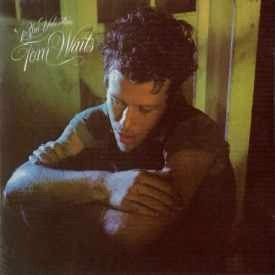 |
Cover for the album: "Blue Valentine". Photography by Elliot Gilbert |
| Late '78 | Released: single: "Somewhere" (Asylum) |
| Oct. '78 | Start tour promoting Blue Valentine: October 1978 - December 1979 (album released: September, 1978). Tom Waits: vocals, electric guitar, piano. Herbert Hardesty: tenor saxophone, flugel horn, trumpet. Arthur Richards: electric guitar. Big John Tomassie: drums. Greg Cohen: upright bass. Further reading: Performances: 1976-1980 |
| '78 | Interview by Irwin Stambler. Part of this interview was issued in: "Encyclopedia of pop, rock & soul" (St. Martin's Press). |
| Oct. '78 | Interview for Modern Hi-Fi and Music Sound: "Nighthawks At The Chelsea". Larry Goldstein |
| Dec. 5, '78 | Concert appearance for Austin City Limits TV show (Austin/ USA). Broadcast PBS April 28/ March 24, 1979 |
1979 |
|
| '79 | Released: "Tom Waits For No One". Hand painted animated short featuring: "The One That Got Away". First animated rock video to be filmed live and then animated. Directed by John Lamb. Character design by Keith Newton. Head animator: David Silverman. The 5 1/2 minute animation was filmed live on a set in 1978 in Hollywood at the La Brea stage and completed in 1979. Tom Waits crooning "The One That Got Away" to an apparition of a stripper who is conjured up in an exhaled puff of cigarette smoke, as she taunts him with an erotic strip tease. The live action was photographed using 5 separate cameras. The final edited piece was "rotoscoped" (traced frame by frame and turned into animation). First place winner in the "First Hollywood Erotic Film and Video Festival", 1981. Further reading: Tom Waits For No One |
| Early '79 | Released: single "Somewhere/ Red Shoes By The Drugstore" (Asylum) |
| Early '79 | Waits works on a film script together with Paul Hampton. Tom Waits (1979): "I just started working on the project in December [1978] when I got off the road. I'm working on it with a gentleman by the name of Paul Hampton who used to be Bert Baccarach's old songwriting partner; he used to write for Famous Music in New York during the '50s, writing for Gene Pitney and cats like that. And he is also an actor, and we're collaborating on this film script about a used car dealer in Southern California, and an old friend of his who are reunited on New Year's Eve. It's a nice story. It's about a guy who's a success at being a failure and a guy who's a failure at being a success... Actually we haven't got anyone to release the film yet. The whole thing's being written on spec. The characters are Jack Farley Fairchild, of Fairchild Dord. Torence, California, and Donald Fedore, his partner and side-kick. I never tried anything like this before. I don't find it at all easy. In fact, it's the hardest thing I've ever done... well, the most challenging anyway." (Source: "The Neon Dreams Of Tom Waits", New Musical Express (UK), by John Hamblett. London. May 12, 1979) |
| '79 | Recordings for the Ralph Waite documentary & soundtrack: "On The Nickel" |
| Jul. 26, '79 | Aired: "Tonight In Person" BBC television concert documentary filmed at the BBC television Theatre, London/ UK. Rebroadcast in 1998 in "Later on... Tom Waits" (aka "Later With Jools Holland", presented by Jools Holland. Producer: Serena Cross. Executive Producer: Mark Cooper. BBC, 1998 for UK-Arena) |
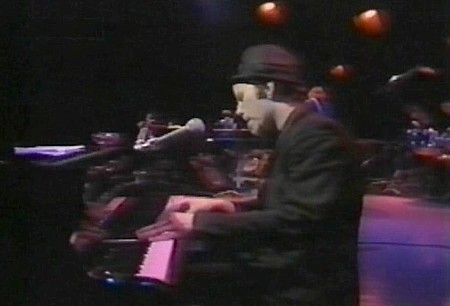 |
TV screenshot from "Tonight In Person" |
| Apr. '79 | Released: debut-album: "Rickie Lee Jones" (A&M/ Warner Bros.). At the age of 24. At about that time Rickie lives in a small Santa Monica apartment. Though she spends most of her time at the LA Tropicana |
| May 5, '79 | Interview for MelodyMaker magazine: "Wry And Danish To Go". Copenhagen, Brian Case/ Tom Sheehan |
| May 12, '79 | Interview for New Musical Express (UK): "The Neon Dreams Of Tom Waits". London/ UK. John Hamblett/ Chris Horler |
| May '79 | Rickie Lee Jones scores a hit with: "Chuck E's In Love". On July 7 it reached 4th position in the American Top-40 |
| May '79 | Waits returns from his latest tour and starts writing for his next album "Heartattack And Vine", which would only be released in 1980 |
| Aug. 4, 79 | Interview for Sounds magazine: "Tom Waits: A Sobering Experience". Dave Lewis/ Susan Carson/ Michael Purtland |
| Aug. 29, '79 | Waits (having returned from Australia) accompanies Rickie Lee Jones on her European tour. Edinburgh Odeon. Edinburgh/ Scotland (Source: Ken Langford, 2005. Verified in Melody Maker, 1979) |
| Sep. 1, '79 | Another commercial success for Rickie Lee Jones with: "Young Blood" |
| Sep. 3, '79 | Waits accompanies Rickie Lee Jones on her European tour. Theatre Carr�. Amsterdam/ The Netherlands (Source: Ken Langford, 2005. Date verified in Melody Maker, 1979) |
| Sep. 5, '79 | Waits accompanies Rickie Lee Jones on her European tour. Manchester Free Trade Hall. Manchester/ UK (Source: Ken Langford, 2005. Date verified in Melody Maker, 1979) |
| Sep. 6, '79 | Waits accompanies Rickie Lee Jones on her European tour. Birmingham Odeon. Birmingham/ UK (Source: Ken Langford, 2005. Date verified in Melody Maker, 1979) |
| Sep. 9, '79 | Waits accompanies Rickie Lee Jones on her European tour. Dominion Theatre. London/ UK (Source: Ken Langford, 2005. Date verified in Melody Maker, 1979) |
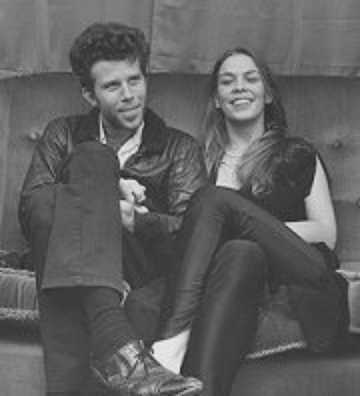 |
Rickie Lee and Waits at the Dominion Theatre, London.September 9, 1979. Credits: photography by Adrian Boot |
| Late '79 | Published: interview with Rickie Lee Jones by Timothy White. Reprinted in 1990 in: "Rock Lives" (Omnibus Press). At that time Waits temporarily stayed in New York City. Late 1979 they would end their relationship. |
| Nov. 2, '79 | Radio appearance (interview) for "WNEW-FM Radio" w. Vin Scelsa. New York City/ USA |
| Dec. '79 | End tour promoting Blue Valentine: October 1978 - December 1979. Further reading: Performances: 1976-1980 |
| Dec. 31, '79 |
Art Fein (2003): "In late 1978 some friends and I began producing private New Years parties, and Chuck and Waits came to the first two. Tom met his wife at the second one, which featured Roy Brown." (Source: "Another Fein Mess/ Other Fein Messes" by Art Fein. March, 2003. Copyright Art Fein) Art Fein (2004): "We held it at Troupers Hall in Hollywood. That one featured Roy Good Rocking Brown with a backup band including Lee Allen and Pee Wee Crayton, and we gave away a '62 Cadillac as the door prize. (Purchased at 4 pm Dec 31st for $200. It went OK in reverse, but forward it slipped out of gear at 20 mph.) Chuck Weiss and Tom Waits came again (buying tickets, like all our friends - nobody got in free, except Johnny Legend, who stiffed us with a bad check) and Tom met his future wife there." (Source: "Another Fein Mess/ Other Fein Messes" by Art Fein. November, 2004. Copyright Art Fein) |
1980 |
|
| Jan. '80 | Waits moves from LA to New York City. Disappointed, disillusioned and trying to get a grip on life. He's fed up with the music industry and he's out of touch with Rickie. He tries to fight his alcoholism, even tries to work on his health and fitness: "I was running down the street to the Y to work out and I had a glass of alcohol in one hand, with some aluminum foil over it so it wouldn't spill, and a cigarette in the other hand,... and I realized I was kind of coming apart."
Jay S. Jacobs (2000): "Bones Howe believes that the real reason Tom chose Manhattan as his new base of operations had nothing to do with scenery changes or shoes or a quest for fresh watering holes. He admits, "You know, Tom did go to New York and try to work with another producer. I was aware of that. He did some demos and stuff. He came back and we talked a lot about what he wanted to do. It was between Blue Valentine and Heartattack and Vine." While in New York, Waits attempted to come to a meeting of the minds with Jack Nitzche and several other producers, but it just wasn't happening for him. None of it - neither the producers nor the city itself. New York, New York may be a wonderful town, where the Bronx is up and the Battery down, but Tom Waits was feeling a little lost." (Source: Telephone conversation with Jay S. Jacobs. Jun. 23, 1999. "Wild Years, The Music and Myth of Tom Waits". Jay S. Jacobs, ECW Press 2000). Stephen Peeples (1980): After working with Bones Howe on every album since your first, I'd heard you were thinking about connecting with Jack Nitzsche for this one. Tom Waits: Yeah, I had some plans to explore new producers. I'd moved to New York for about five-six months, wanting to challenge myself with an entirely new environment. But my relationship with Bones has been a very close and personal one. That for me is more important than anything when you're in the studio - to have somebody you can trust and who knows you, knows who you are and doesn't let you get away with anything. I didn't really want to disturb that relationship. But at the time I thought I wanted to change everything. Then I decided that the change was something that had to take place inside of me and with my own musical growth. I wanted to take some dangerous chances, and I felt Bones could best accommodate me. (Source: "Heartattack and Vine". Us promo pack: Stephen Peeples. September 4 1980.) In New York Waits is approached by Francis Ford Coppola. He'll stay in NY until Apr. 30 1980. It's the beginning of the turning point in his life. Further reading: One From The Heart |
| Feb. 17, '80 | Radio appearance for "WPIX FM", New York/ USA. Waits acts as a DJ and conducts a phone-in |
| '80 | Released: TV documentary: "On The Nickel" by Ralph Waite. The sensitive story of two down-and-out alcoholics living in the skid-row area of downtown Los Angeles. |
| '80 | Released: movie "Bad Timing" (w. Art Garfunkel and Harvey Keitel) by Nicolas Roeg. With: "Invitation To The Blues" on the soundtrack |
| Apr. '80 | Waits returns from NY to LA. The whole year through he works on the soundtrack for Coppola's: "One From The Heart". In the Zoetrope studios he's given an office of his own. This project would take Waits a full 18 months. This is where he would meet his future wife Kathleen Brennan. Further reading: One From The Heart |
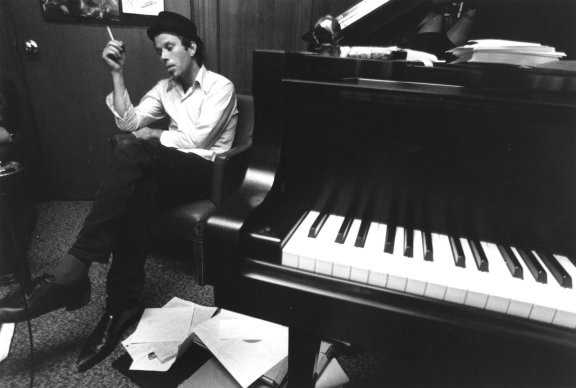 |
Waits at the Zoetrope studios. From "BAM" magazine. February 26, 1982. Date: Hollywood, Zoetrope studio's. 1980/ 1981. Credits: photography by Henry Diltz |
| Jun. 16 - Jul. 15, '80 | Recordings for the album "Heartattack And Vine" in the Filmways/ Heider Studios, Hollywood. Waits even moves to the RCA building on Ivar and Sunset. As the recordings are finished, he doesn't go for a tour as he used to, but returns to the Zoetrope studios continuing his work for "One From The Heart" |
| Aug. 10, '80 | Marriage with Kathleen Patricia Brennan. The two first met at the 1980 New Years party thrown by Art Fein and later became acquainted when they met again at Zoetrope studio's. Kathleen was a script-analyst at Coppola's Zoetrope studios (unverified). After the two got married, they moved to Union Avenue in LA. Barney Hoskyns (2009): "The following weekend Tom and Kathleen celebrated their nuptials with a raucous gathering at Molly Malone's on Fairfax Avenue. Everybody from Bones Howe and Herb Cohen to Jerry Yester and Michael Hacker to Bobi Thomas and Francis Thumm showed up. Greg Cohen got talking with Kathleen's sister Marguerite, an artist and potter, and two years later they too would marry. Waits, says Yester, was "just the happiest I'd ever seen him." The marriage reminded him of "a good version" of the ending to Sunset Boulevard: "Kathleen was kind of like the girl in that movie working in the script department." (Source: Jerry Yester interview June 8, 2007 as quoted in “Lowside Of The Road: A Life Of Tom Waits" by Barney Hoskyns. Faber/ Broadway, 2009) |
| Sep. '80 | Released: "Heartattack And Vine" (Elektra Entertainment). Produced by: Bones Howe. No referring to Chuck E. Weiss and Rickie Lee Jones |
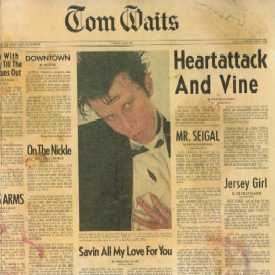 |
Cover of the album: "Heartattack And Vine". Photography by Greg Gorman |
| Sep. 4, '80 | Promotional interview by Stephen Peeples for the "Heartattack And Vine Promo Pack" |
| Sep. 28 - oct. 26, '80 | Staging of Steppenwolf Theatre Company's production of Lanford Wilson's "Balm In Gilead". Directed by John Malkovich and featuring: Francis Guinan, Glenne Headly, Tom Irwin, Terry Kinney (Fick, Stranger), Laurie Metcalf, Jeff Perry and Gary Sinise (Dopey). The production ran in Chicago first on the Steppenwolf stage (September 28 - October 26, 1980) and again at the Chicago Apollo Theater Center (July 8 - August 30, 1981). It was then remounted in 1984 in New York at the Circle Repertory Theatre (May 15, 1984) and eventually moved to the larger Minetta Lane Theatre. The production ran from May 1984 through the end of the summer. With the three different mountings of the production there was some variation in casting." Some of Waits' songs were used for the play and it got Waits to meet the people from Steppenwolf (New York, 1984) which led to them working together for the staging of Frank's Wild Years in 1986. Tom Waits (1986): "In New York I met Gary Sinise and Terry Kinney and John Malkovitch. They used some of my songs in Balm In Gilead that was done there and we saw the play so we started talking." (Source: WXRT-FM Radio Interview. Date: Chicago. July 11, 1986) |
| Oct. '80 | Start of the studio recordings for the album "One From The Heart" with Crystal Gayle at Wally Heider Recording, Hollywood. Further reading: One From The Heart |
| Oct. 11, '80 | TV appearance for the "Smothers Brothers TV Special", Los Angeles/ USA (broadcast October 28, 1980). |
| Nov. '80 | Start tour promoting Heartattack And Vine: November 1980 - October 1981 (album released: September, 1980). Tom Waits: vocals, piano, electric guitar. Teddy Edwards: tenor saxophone. Greg Cohen: upright bass. Further reading: Performances: 1976-1980 |
| Nov. 29 '80 | Aired: "Roadshow" WMAQ-Channel 5 (NBC) television program. Starring: John Candy, Greta Blackburn, Julie Brown, Greg Monaghan, Rick Overton, Budge Threlkeld, Father Guido Sarducci. Directed by: Chuck Braverman. The 90-minute pilot has an interview and two live songs (Heartattack And Vine, Jersey Girl) from a pre-recorded show at the Park West Theatre (Chicago/ USA. November 11, 1980) |
|
Further reading |
|

